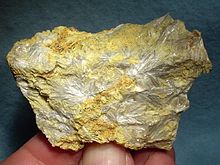| Valentinite | |
|---|---|
 A sample of valentinite from Algeria (size: 6.9 x 4.4 x 3.3 cm) | |
| General | |
| Category | Oxide minerals |
| Formula (repeating unit) | Sb2O3 |
| IMA symbol | Vln[1] |
| Strunz classification | 4.CB.55 |
| Crystal system | Orthorhombic |
| Crystal class | Dipyramidal (mmm) H-M symbol: (2/m 2/m 2/m) |
| Space group | Pccn |
| Unit cell | a = 4.91 Å, b = 12.46 Å c = 5.42 Å; Z = 4 |
| Identification | |
| Color | Colorless, snow-white, pale yellow, pink, gray to brownish |
| Crystal habit | Prismatic crystals, sometimes flattened, fan-shaped or stellate aggregates of crystals; lamellar, columnar, granular, massive. |
| Cleavage | {110}, perfect; {010}, imperfect |
| Tenacity | Brittle |
| Mohs scale hardness | 2.5–3 |
| Luster | Adamantine, pearly on cleavages |
| Streak | White |
| Diaphaneity | Transparent to translucent |
| Specific gravity | 5.76 |
| Optical properties | Biaxial (−) |
| Refractive index | nα = 2.180 nβ = 2.350 nγ = 2.350 |
| Birefringence | δ = 0.170 |
| 2V angle | Very small |
| References | [2][3][4] |
Valentinite is an antimony oxide mineral with formula Sb2O3. Valentinite crystallizes in the orthorhombic system and typically forms as radiating clusters of euhedral crystals or as fibrous masses. It is colorless to white with occasional shades or tints of yellow and red. It has a Mohs hardness of 2.5 to 3 and a specific gravity of 5.76.[5] Valentinite occurs as a weathering product of stibnite and other antimony minerals. It is dimorphous with the isometric antimony oxide senarmontite.[2]
- ^ Warr, L.N. (2021). "IMA–CNMNC approved mineral symbols". Mineralogical Magazine. 85 (3): 291–320. Bibcode:2021MinM...85..291W. doi:10.1180/mgm.2021.43. S2CID 235729616.
- ^ a b Handbook of Mineralogy
- ^ Mindat with location data
- ^ Webmineral data
- ^ Pradyot Patnaik. Handbook of Inorganic Chemicals. McGraw-Hill, 2002, ISBN 0-07-049439-8